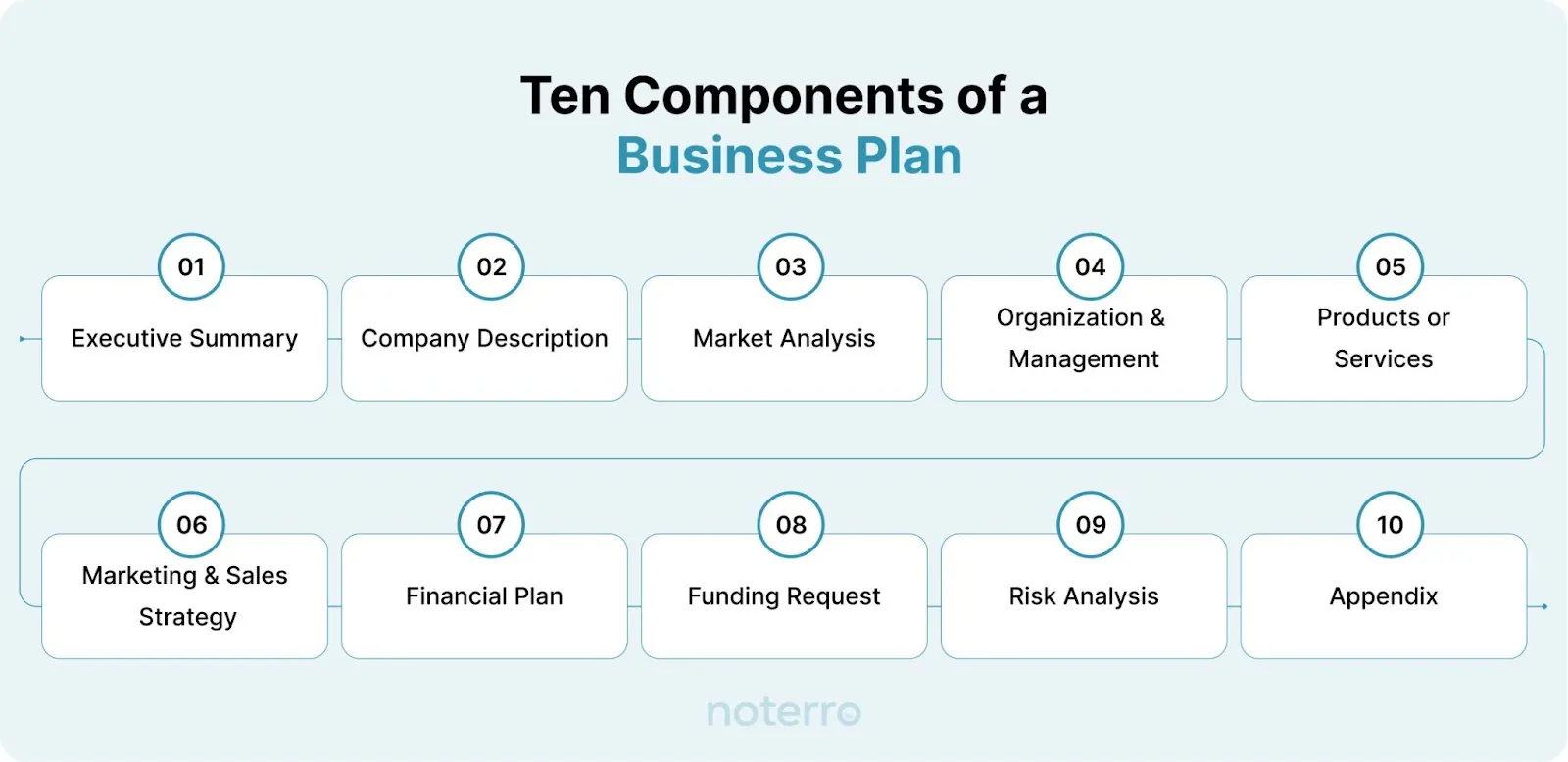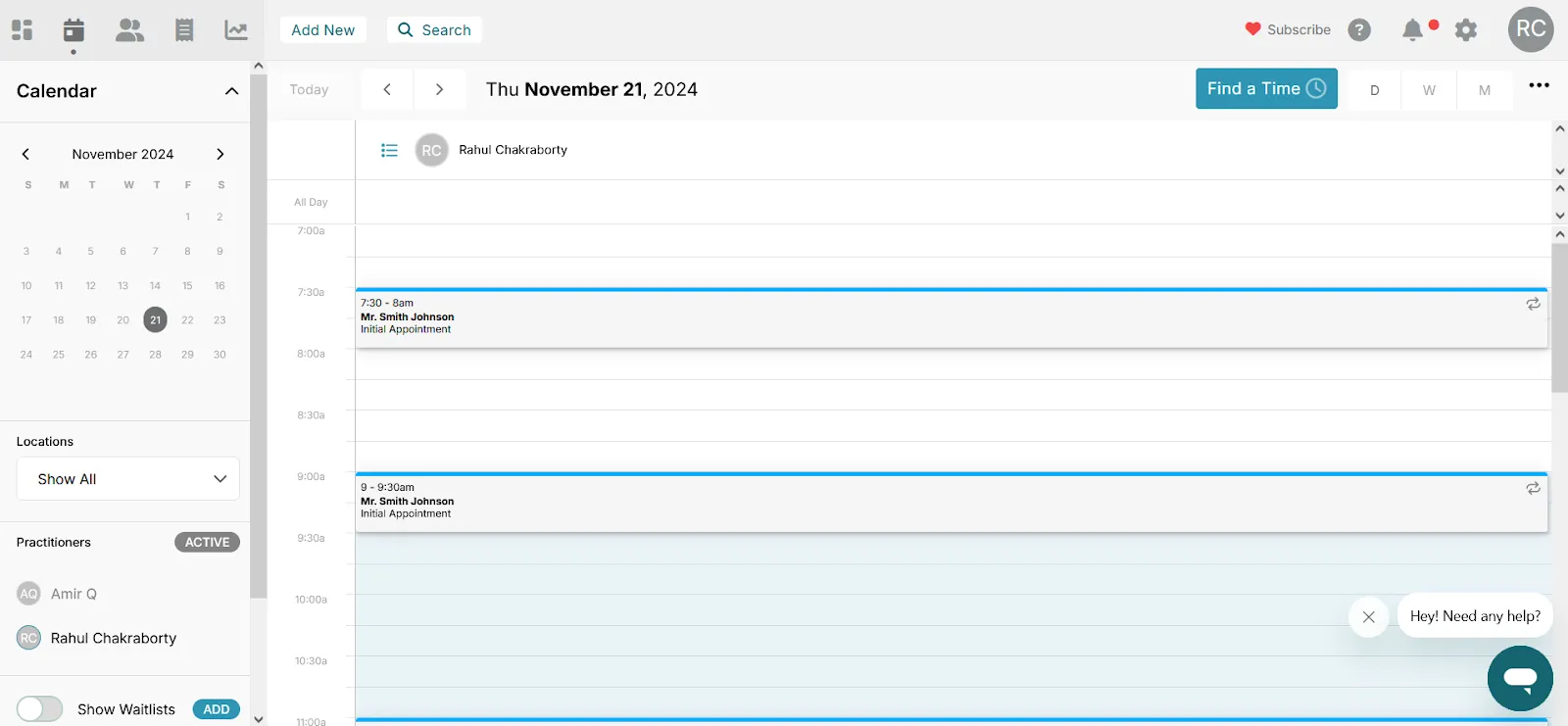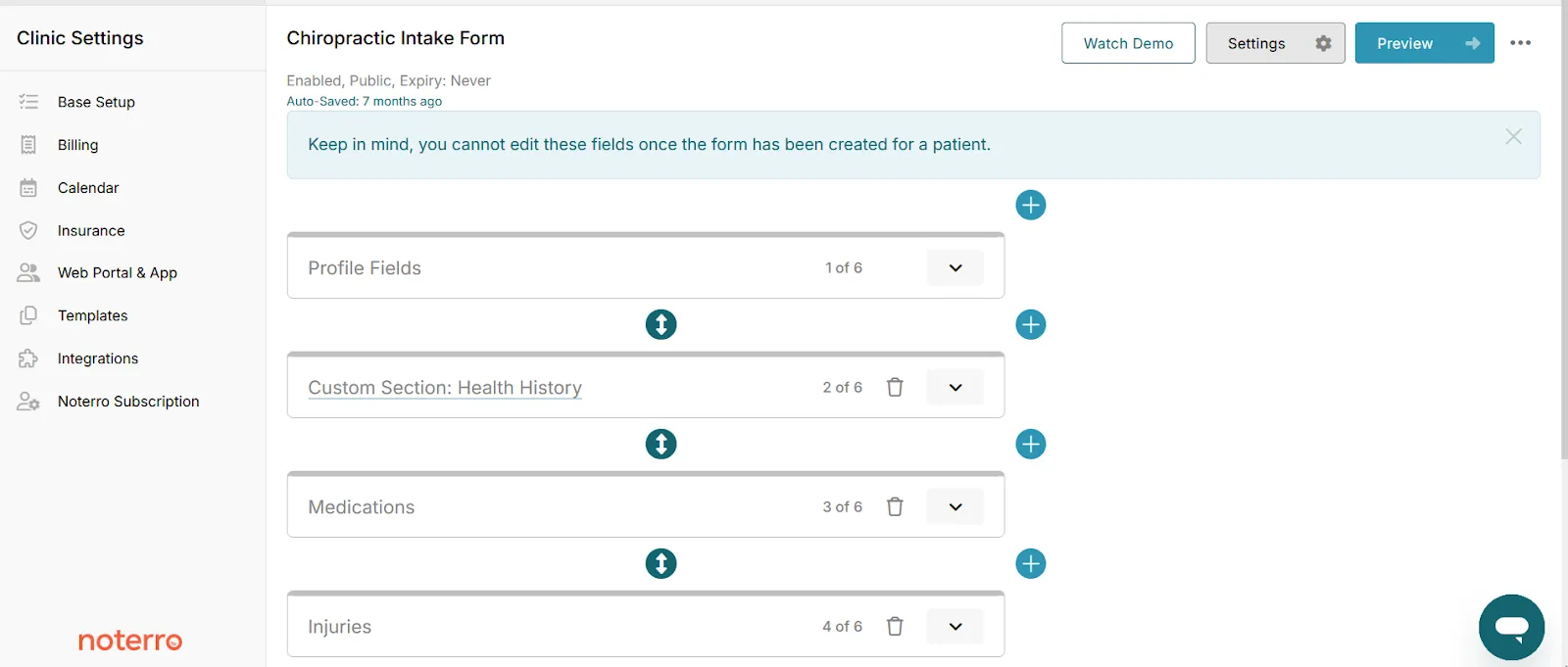End-of-Year Sale: Subscribe by December 31 to Get 3 Months Free!
Learn More
Table of Contents

Experience Better Practice Management Today!
Starting at $28.05/month
No Credit Card Required

Experience Better Practice Management Today!
Starting at $30/month
No Credit Card Required
Starting a chiropractic practice lets you make a real impact, helping people like parents with chronic back pain or athletes recovering from injury.
The chiropractic industry is strong, valued at $20.6 billion in 2024 in the U.S., with projected growth of 0.5% annually. As more people seek spinal health and wellness, the demand for chiropractors is rising.

In this guide, I’ll walk you through the steps of starting your chiropractic practice in 2025. With my experience in the field, I’ve created a simple roadmap to help you get started, whether you’re looking to go independent, freelance, or move from a larger clinic.
Starting a chiropractic practice is an exciting venture, but success begins with careful planning and strategic decisions. Here’s a checklist to help you lay the foundation for a patient-centered practice, from choosing the right location to selecting chiropractic practice management software.
Building a successful chiropractic practice starts with understanding your market, defining your niche, and setting clear goals
To create a successful chiropractic business, you need to deeply understand the market landscape. Research local and national trends to understand the demand for chiropractic services. In the U.S., chiropractors earn a median annual salary of $76,530, with top earners making up to $142,580. These figures vary depending on location and competition.
Use Google Maps and Yelp to identify nearby chiropractic practices. Look at their services, pricing, and patient reviews. For instance, are they offering wellness packages or focusing solely on adjustments?
Evaluate underserved areas or overlooked services. For example, if most local clinics focus on injury recovery, you might specialize in ergonomic assessments or wellness care.
Research your community’s needs. Are you surrounded by families, seniors, or busy professionals? Each group has distinct chiropractic needs. Families may value pediatric care, while seniors may seek gentle, mobility-focused adjustments.
If no one caters to desk-bound professionals in your area, consider positioning your practice as the go-to for ergonomic consultations and stress-relief treatments.
Chiropractic business is a relatively competitive area, and it’s not enough to be a generalist. A well-defined niche allows you to focus your marketing, tailor your services, and build a loyal client base in your chiropractic business model.
So, what niches are available for you?
Remember that your niche should align with both your interests and your community’s needs. For example, if you’re located near office complexes, focusing on corporate care may make sense.
On the other hand, a suburban area with young families may respond better to pediatric care.
Pro Tip: Research local demographics to match your niche to the market. For example, areas near gyms or yoga studios are likely to have a higher demand for sports chiropractic services.
Once you understand your market and niche, it’s time to map out your vision. SMART goals give you direction, help measure your progress, and ensure that your business stays aligned with your long-term aspirations.
Example: Build a base of 30 regular patients within the first three months.
Example: Achieve $15,000 in monthly revenue by the second quarter.
Example: Begin with one or two specialties before expanding your offerings.
Example: If targeting families, focus on pediatric care packages and promotions.
Example: Secure a partnership with a local gym by the end of your first year.

Pro Tip: Many business owners have told me that they revisit their goals every quarter to assess their progress and make adjustments as needed. Doing this will allow you to stay flexible and responsive to market changes.
A well-crafted chiropractic business plan is the foundation of your chiropractic practice. It serves as a roadmap to success, helping you anticipate challenges, prepare solutions, and set clear goals.

Executive Summary: This section offers an overview of your vision, mission, and values. It should answer the question: “Why does this business exist, and how will it succeed?”
Pro Tip: Keep this section brief but impactful. I’d say revisit and refine it as your business evolves, ensuring it always reflects your core purpose.
Service Portfolio: What services will you offer? Highlight how your services meet your target audience’s needs and set your practice apart.
Pro Tip: Prioritize durability and ergonomic features when selecting equipment to ensure both practitioner efficiency and patient comfort.
Pricing Strategy: Chiropractic session fees range between $60 and $200, depending on the region and services offered. Flexible pricing models, such as membership plans or multi-session bundles, can help boost patient retention.
Cash-Based Practice: If you’re considering a cash-based model, it allows more control over finances and pricing flexibility. Establish transparent pricing and ensure patients understand the value of out-of-pocket payments for personalized care.
Pro Tip: I’d recommend you research your competitors’ pricing but don’t undersell your expertise. Focus on delivering exceptional patient care to justify premium rates.
Also read: 9 Clever Data Strategies to Boost Patient Stickiness for Chiropractors
Market Analysis: Understanding your market is critical for tailoring your business plan to meet local demand. A thorough analysis answers questions like:
For example, if your clinic is near an office district, focusing on ergonomic consultations and corporate partnerships could be a strategic move.
Pro Tip: I’ve found that Google Maps is great for checking out competitors and reviews. Use local census data to get a feel for demographics, and Google Trends to track interest in services like “sports chiropractic.” I also recommend adding surveys or focus groups to get real insights from your community.
Pro Tip: Prioritize durability and ergonomic features when selecting equipment to ensure both practitioner efficiency and patient comfort
Once the basics are covered, invest in furnishings and décor to create a warm and inviting atmosphere.
Comfortable seating, soothing lighting, and tasteful artwork for your waiting room may require an additional $1,000 to $3,000. A thoughtfully designed space reflects professionalism and helps patients feel at ease.

Pro Tip: Choosing software that grows with your practice ensures long-term value and avoids switching costs down the line.
This analysis gives you a clear target for customer acquisition and helps you plan your workload effectively.
Let me share some cost-effective marketing strategies to make getting started a bit easier:
Once you’ve calculated your startup costs, explore funding options to bring your business plan to life.
Pricing should reflect your expertise, the quality of your services, and your target market’s expectations. It’s not just about numbers; it’s about positioning your practice for long-term profitability.
As mentioned above, the Chiropractic session fees typically range from $65 to $200 per session, depending on the service type and region. For example:
To fine-tune your pricing:
The Value of Specialization
Specialized services often justify premium pricing. For instance:
Pro Tip: I’ve seen firsthand how important it is for practices to highlight what sets them apart. Whether it’s advanced techniques, personalized care, or the ease of online booking, make sure your patients understand the real value they’re getting.
Flexible pricing models are a smart way to attract a diverse range of patients while building loyalty. A one-size-fits-all approach might limit your potential, but offering options ensures you can meet varying needs and budgets.
By offering flexible pricing, you can appeal to a broader audience, encourage repeat visits, and ensure your practice’s financial stability.
To understand how flexible pricing can stabilize and grow your income, consider this scenario:
Then, your total monthly revenue would be $6,575. By combining standard rates with packages and memberships, you create multiple revenue streams that build financial stability and patient retention.
Pro Tip: Revisit your pricing strategy every 6–12 months. Adjust for market trends, increased experience, and added services to stay competitive while maximizing profitability.
Chiropractic is a highly regulated profession. To practice legally and build patient trust, obtaining the necessary licenses, certifications, and insurance is essential.
Pro Tip: Look for specialized insurance providers for chiropractors to secure comprehensive coverage tailored to your practice’s needs.
The location of your chiropractic practice plays a vital role in your success. It impacts the accessibility of your services, your operational costs, and your overall growth potential.
Whether you're starting small or expanding into a larger clinic, your choice of location shapes both your business operations and the patient experience.
Choosing the right location also depends on the business model you adopt. Here are three options to consider:
Recommended Read: How to Maximize Your Practice Growth with Chiropractic Scheduling Software
Regardless of your chosen business model, the location of your practice, or your service area for mobile services, has a significant impact on your success. Here’s what I’d recommend you should consider:
Choose a location that's easy for patients to reach. Look for places with ample parking and proximity to public transport. If your clinic is hard to access, patients may seek alternatives, even if your services are top-notch.
Select high-traffic areas, such as near gyms, office buildings, or community centers. These locations help attract walk-in patients and increase brand awareness. Clear signage and a visible storefront can significantly improve your chances of gaining new clients.
Ensure that the property complies with local zoning laws and health regulations before signing a lease. Non-compliance can result in fines, delays, or even prevent you from opening your clinic.
Pro Tip: If leasing a space, negotiate for rent-free months during the buildout phase. This can offset initial costs like renovations and equipment setup.
The equipment you select plays a crucial role in defining the quality of care you offer and shaping your patients’ experience. Choosing high-quality, reliable tools not only ensures smooth operations but also builds trust with your patients.
Equipping your practice thoughtfully is essential to create a professional environment that promotes efficient workflows and outstanding patient care.
Your chiropractic table is the focal point of your practice. Prices range from $500 for basic models to $5,000 for advanced, multi-functional tables. Look for ergonomic designs that support patient comfort and also promote your own posture during treatments. Comfortable patients lead to better outcomes and retention, so investing in a top-tier table is a must.
For clinics offering advanced services, invest in diagnostic tools like X-ray machines (ranging from $10,000 to $20,000). These tools allow you to assess patient needs more precisely and provide targeted treatments, particularly if you specialize in injury recovery or spinal decompression services. Offering these services can also make your practice stand out from competitors.
Creating a welcoming office space is just as important. Budget between $1,000 and $3,000 for items like waiting room chairs, desks, patient intake forms, and signage. A clean, organized office enhances patient trust and comfort, encouraging them to return. Simple touches like calming colors and accessible furniture can greatly improve the overall atmosphere.
Also Read: The Ultimate Guide to Patient Intake Software in Chiropractic Care
Pro Tip: Outfitting your practice doesn’t have to break the bank. You can find high-quality used equipment from trusted suppliers and build up your inventory as your practice grows. I also recommend setting aside a contingency fund for unexpected repairs or equipment replacements to keep things running smoothly without interruptions.
Leverage Technology and Chiropractic Software
Managing a chiropractic practice involves unique challenges. Practice management software like Noterro is designed to streamline operations while improving patient care. Here's how its features can meet your chiropractic practice's needs:
Managing recurring appointments and streamlining payment collection, including insurance billing claims, becomes effortless with Noterro. This frees you up to focus on patient care while avoiding the burden of administrative tasks. With automated payment reminders and easy claims processing, your financial management becomes seamless.
Noterro provides secure access to patient histories, SOAP notes, and treatment plans, ensuring compliance while enabling personalized care for each visit. Efficient record-keeping allows for quick, accurate patient data retrieval—saving time and ensuring you provide the best care.
Also Read: 5 Time-Saving Techniques for Streamlining SOAP Note Writing
They reduce no-shows and missed appointments, which can disrupt treatment schedules and patient outcomes. Noterro’s automated reminders, delivered via email, text, or call, keep patients on track with their care, improving engagement and retention.
From patient intake forms to consent forms, Noterro offers fully customizable options, enabling you to gather accurate information efficiently. This reduces paperwork and streamlines your workflow, giving you more time to focus on patient care.
Noterro helps you manage your practice while creating a smooth and professional experience for your patients. This boosts their satisfaction and makes your workflow more efficient.

Here’s something interesting: Navigating the Best Chiropractic Software for Peak Performance.
Pro Tip: I’ve found that integrating payment systems like Square can really enhance the patient experience by offering flexible payment options, like credit cards and digital wallets. Noterro’s secure Square integration makes managing payments a breeze, helping your clinic run smoothly.
Your brand is more than just a logo. It represents the personality of your chiropractic practice. A strong brand shapes how patients perceive you, sets you apart from competitors, and helps build trust. Thoughtful branding reflects your values, your expertise, and the unique care you offer. This makes your practice memorable and relatable to your audience.
Your brand identity starts with the basics: your logo, tagline, and communication style. These elements should reflect your niche and appeal to your target audience.
Design a logo and tagline that communicate your practice’s values and focus. For example, a family-oriented practice could use warm colors with a tagline like “Caring for spines, nurturing families.” Alternatively, a sports chiropractic clinic might opt for bold typography with a tagline like “Where recovery meets performance.”
Your brand voice is how you communicate with your patients. It should reflect your practice’s personality. Decide if your tone will be:
By keeping your voice consistent, patients know exactly what to expect when interacting with your practice.
Your online presence serves as your digital storefront and often forms the first impression for potential patients. A well-crafted online presence enhances credibility, attracts patients, and keeps them engaged.
A well-designed, SEO-optimized website is essential for modern branding. Here’s what to include:
Adding a blog can also increase visibility. For example, a blog titled “Top 5 Benefits of Chiropractic Care for Desk Workers” can attract local professionals searching for solutions to back pain.
Recommended Read: 5 Ways Chiropractors Are Earning More With Booking Software
Social media platforms such as Instagram, LinkedIn, and Facebook are powerful tools for connecting with patients. Share content that resonates with your audience:
High-quality visuals can significantly enhance your brand. Investing in professional photography for your clinic, staff, and treatment sessions (with patient consent) creates a polished and trustworthy image.
Great visuals not only make your practice look professional but also help build credibility with patients.
A thriving chiropractic clinic depends on a steady stream of patients, and effective marketing is key to achieving this. By combining local outreach with online advertising, you can attract new clients, build your reputation, and create lasting relationships within your community.
Your local community is your most loyal and accessible audience. Building relationships with complementary businesses and organizations can amplify your reach.
Pro Tip: Referral programs can do wonders for building your patient base. Offering a discount to loyal clients who refer new patients not only rewards them but also helps you attract more business. It’s a win-win for everyone.
Online platforms are invaluable for expanding your reach and targeting specific patient groups.
Effective ads with engaging visuals, like a short video highlighting your clinic’s welcoming atmosphere and patient-centered care, can help your practice stand out in a competitive market.
Interesting Read: How to Turn Your Chiropractic Clinic into a Patient Magnet
Pro Tip: From my experience, combining local outreach with online advertising works best. Promote a community workshop on social media and offer attendees a discount for their first visit. It’s a simple way to reach a broad audience while staying connected to the local community.
Managing a chiropractic practice extends beyond patient care—it requires efficient operations and sound financial oversight. By streamlining these areas, you can focus on providing quality care while ensuring your practice remains financially stable.
Operational efficiency is the backbone of a well-run clinic. Using clinic management software for chiropractors, like Noterro, can centralize and automate many administrative tasks, saving you time and minimizing errors.
Recommended Read: Chiropractic SOAP Notes Software for Better Patient Management
These tools not only enhance workflow but also free up your time to focus on patient care, rather than administrative tasks.
Pro Tip: Developing Standard Operating Procedures (SOPs) ensures consistency in your clinic’s operations. SOPs for patient intake, cleaning protocols, and appointment cancellations will help create a smooth, efficient, and compliant workflow.
Staying on top of your clinic’s finances is crucial for long-term success. Start by setting realistic revenue projections. For example, if you charge $100 per session and see 20 patients a week, your potential revenue would be $8,000 per month. Regularly tracking income and expenses helps you monitor your financial progress and identify areas for improvement.
Pro Tip: Work with an accountant to ensure you’re maximizing tax deductions, staying compliant with local regulations, and optimizing your financial planning. Integrating practice management software like Noterro with accounting platforms such as QuickBooks can simplify the process, ensuring smooth financial operations.
Strong financial management is essential for the long-term success of your chiropractic practice. By carefully tracking income, managing expenses, and staying on top of taxes, you ensure your practice remains profitable and prepared for growth.
Tracking cash flow is crucial to understanding the financial health of your practice. Tools like QuickBooks and Xero allow you to easily categorize expenses, monitor revenue, and generate comprehensive reports.
To streamline this process, consider using Noterro, which integrates seamlessly with both QuickBooks and Xero. This integration enables you to sync billing, payments, and client records, saving you time and reducing errors.
Pro Tip: Regularly review your cash flow to identify areas for improvement and ensure you are meeting your financial goals.
Understand Basic Tax Requirements
Managing taxes is a critical part of running your practice. Staying compliant with tax regulations helps avoid penalties and keeps your finances on track.
By integrating Noterro with accounting platforms like QuickBooks and consulting tax professionals, you can simplify your financial management, focus more on patient care, and set your practice up for long-term success.
Pro Tip: In my experience, working with a tax professional is key to maximizing your deductions. It includes things like equipment costs, software subscriptions, and office expenses. It helps keep your tax liability down and your finances in check.
Your launch day marks the beginning of your chiropractic practice’s journey. A well-executed launch not only attracts new patients but also sets the tone for your practice’s success.
By combining a soft opening with a grand launch event, you can refine your processes while creating excitement and buzz within your community.
Begin with a soft opening to test your workflow and gather valuable feedback. Invite family, friends, or trusted acquaintances for trial sessions. Use this opportunity to:
A soft launch allows you to identify and address any operational hiccups before welcoming a broader audience, ensuring a polished experience for your official opening.
Your grand opening is the perfect opportunity to make a memorable first impression and attract a steady stream of patients. Here’s how to make it impactful:
For example, a promotion like “Book an adjustment during opening week and get a free ergonomic consultation” can create urgency while demonstrating the value of your services.
Pro Tip: I always recommend collecting feedback from patients after every session, especially in the first few weeks. Whether it's through online surveys or just chatting with them in person, the insights you get will help you improve and create a better patient experience.
Starting a chiropractic practice is an exciting journey that blends your passion for patient care with the drive to succeed.
This guide has covered key insights like cash-based practices, insurance billing integrations, and patient engagement strategies to make sure you’re ready to launch and grow your practice.
By defining your niche, choosing the right tools like Noterro’s chiropractic software, and setting clear goals, you can build a strong foundation for a patient-centered practice.
With solid preparation and a focus on client satisfaction, you’ll set yourself up for long-term growth, financial stability, and professional success.
Your chiropractic practice and your patients are waiting. Take the first step with confidence today.
Chiropractors typically work in private practices, wellness clinics, sports medicine facilities, rehabilitation centers, and hospitals.
Starting a chiropractic business involves obtaining the necessary qualifications (D.C.), setting up a business plan, finding a location, investing in tools, and marketing your services to build a patient base.
Success comes from a combination of technical expertise, personalized patient care, effective marketing, and using practice management tools to streamline operations.
Beyond clinical expertise, successful chiropractors need skills in business management, patient relations, marketing, financial management, and operational efficiency to keep the practice running smoothly.
Continuing education is essential to stay current with the latest techniques, trends, and treatment options. Many states also require chiropractors to complete continuing education credits for license renewal.
Use efficient practice management software like Noterro to automate scheduling, billing, and documentation. Setting up systems for marketing, finances, and patient care can save time and allow you to focus on treating patients.
Tags



